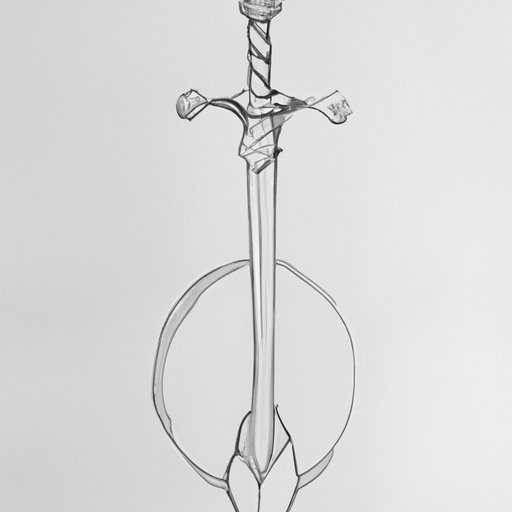
Introduction
Swords have held a fascination for people for centuries. They are symbols of power, strength, and protection, and learning to draw one can be an exciting challenge. Whether you’re a beginner or more experienced artist, drawing a sword requires skill and technique. In this article, we’ll explore different ways to draw a sword, from basic techniques to more advanced ones. We’ll also cover how to find inspiration, add meaning to your drawing, and take your skills to the next level.
Master the Art of Drawing Swords: A Beginner’s Guide
Before starting your sword drawing, it’s essential to master proper technique. Holding your pencil or pen correctly can make a big difference in the quality of your work. Start by gripping your pencil lightly, using your fingertips and not pressing down too hard. This will make it easier to control the lines and strokes of your drawing.
To draw a basic sword, begin by sketching the hilt, or handle. Draw a straight line for the blade, and add a pointed tip at the end. Then, add a curved line above the handle to show the guard, or crossbar, that protects the hand of the person wielding the sword. From there, add detail, such as the texture of the handle or the pattern on the blade. Practicing these basic techniques will help you gain confidence and lay the groundwork for more complex drawings.
To add depth and dimension to your sword drawing, try using shading techniques. Shading can help show shape and form and add realism to your drawing. Start by identifying the light source in your drawing and shading the areas that would be in shadow. Then, use a blending tool, such as a small piece of tissue paper or a blending stump, to create a smooth transition between dark and light areas. Practice shading techniques with different degrees of pressure to see how they affect your drawing.
From Pencil to Paper: Drawing a Sword Like a Pro
Drawing a sword is not just about technique—it’s also about visualizing the sword in your mind. Before starting your drawing, try to imagine the sword in 3D space. This can help you plan the perspective and position the sword at the right angle. Once you have a clear image in your head, begin sketching the hilt, blade, and point.
For more complex swords, such as medieval or fantasy swords, add details such as decorative elements, markings, or a unique shape. Practice your shading technique to show the texture of the sword’s surface and the reflections of light on the metal. You can also experiment with different techniques, such as cross-hatching or stippling, to add depth and texture to your drawing.
Finding Inspiration for Your Sword Drawing
One way of finding inspiration for your sword drawing is by researching different sword designs. Look at swords from different cultures and historical periods to get a sense of the styles and shapes that appeal to you. You can also browse artwork by other artists to see how they interpret the sword in their medium.
To make your drawing unique, try experimenting with different elements such as color, texture, or lighting. These can help create a mood or tone that reflects the message you want to convey with your drawing. Don’t be afraid to try new things and see what works best for you.
Swords and Symbols: The Art of Drawing a Sword with Meaning
As symbols of power and strength, swords can represent many things, such as honor, justice, or protection. When drawing a sword, think about the message you want to convey with your artwork. Consider the color choice of the sword, the position of the sword in the drawing, and any additional elements that can help convey the meaning behind the artwork.
For example, if you want to create a drawing that conveys a sense of danger or risk-taking, you might choose to include a sword with a jagged, uneven blade. On the other hand, if you want to evoke a sense of calm and balance, you might consider a more symmetrical sword with a smooth, polished surface.
Taking Your Sword Drawing to the Next Level: Advanced Techniques
If you’re looking to take your sword drawing to the next level, consider using 3D software to create more intricate models. This can help you visualize the sword from every angle and create a more detailed and realistic drawing. You can also experiment with adding elements such as fire or water to make your drawing more dynamic.
Another way to enhance your drawing is by exploring different color palettes and creating interesting compositions. Try using contrasting colors or bold, vibrant hues to make your drawing stand out. You can also experiment with different compositions, such as placing the sword at an angle or using negative space to draw attention to the sword.
From Sketch to Masterpiece: Turning Your Sword Drawing into Art
For those who want to turn their sword drawing into art, consider exploring new mediums. You might try working with clay to create 3D models of your sword or using digital software to create a fully-rendered image. These new mediums can help you refine your technique and develop your own unique style.
You can also showcase your artwork by entering contests, sharing it on social media, or even exhibiting it at galleries or conventions. By sharing your work with others, you can get feedback, grow as an artist, and inspire others to explore the world of sword drawing.
Conclusion
If you’re interested in drawing swords, remember to start with the basics and practice proper technique. From there, experiment with different styles and techniques, find inspiration in the world around you, and explore the meaning behind your artwork. By combining these elements, you can create sword drawings that are unique, powerful, and true works of art.





